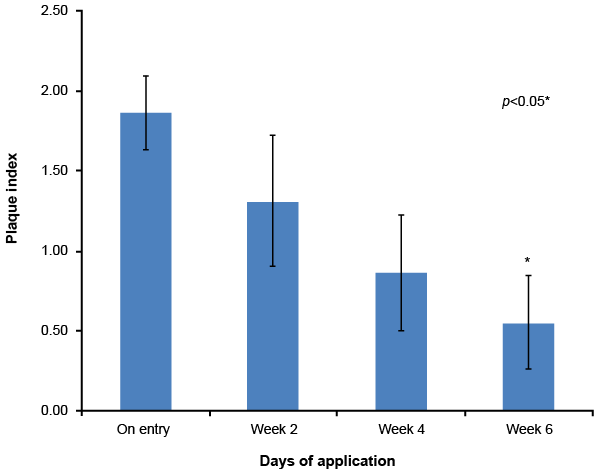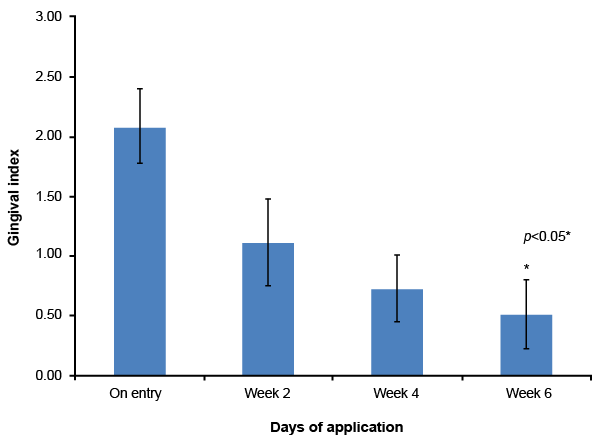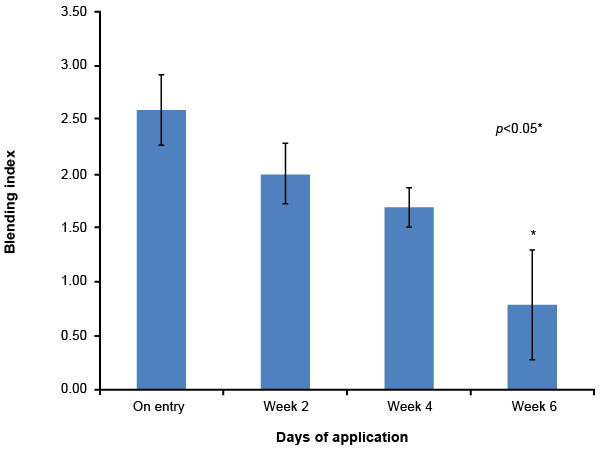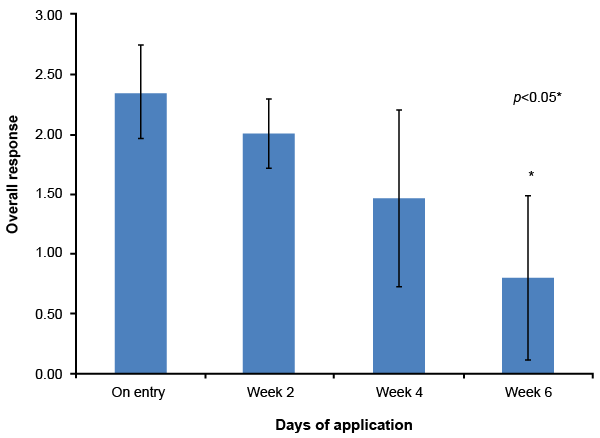Research Article Open Access
Evaluation of the Safety and Efficacy of Complete Care Herbal Toothpaste in Controlling Dental Plaque, Gingival Bleeding and Periodontal Diseases
| Pralhad S Patki1*, Madhumita Mazumdar2, Swapan Majumdar3 and Aritra Chatterjee3 | |
| 1Head-Medical Services & Clinical Trials, R&D Center, The Himalaya Drug Company, Makali, Bangalore, India | |
| 2Head-Medical Services, The Himalaya Drug Company, Bangalore, India | |
| 3Head, Dept of Oral Medicine, Diagnosis & Radiology, Dr. R. Ahmed Dental College & Hospital, Kolkata-14, India | |
| Corresponding Author : | Pralhad S Patki, M.D Head - Medical Services & Clinical Trials R&D Center The Himalaya Drug Company Bangalore-562 123, India Tel: 9108023714444 Fax: 91 08023714471 E-mail: dr.patki@himalayahealthcare.com |
| Received May 07, 2013; Accepted June 24, 2013; Published July 01, 2013 | |
| Citation: Mazumdar M, Chatterjee A, Majumdar S, Chandrika M, Patki PS (2013) Evaluation of the Safety and Efficacy of Complete Care Herbal Toothpaste in Controlling Dental Plaque, Gingival Bleeding and Periodontal Diseases. J Homeop Ayurv Med 2:124. doi: 10.4172/2167-1206.1000124 | |
| Copyright: © 2013 Mazumdar M, et al. This is an open-access article distributed under the terms of the Creative Commons Attribution License, which permits unrestricted use, distribution, and reproduction in any medium, provided the original author and source are credited. | |
Visit for more related articles at Journal of Traditional Medicine & Clinical Naturopathy
Abstract
Aim: The aim of the study is evaluation of safety and efficacy of complete Care Herbal Toothpaste in controlling dental plaque, gingival bleeding and periodontal diseases.
Materials and methods: A hundred subjects of both sex with dental plaque and other dental problems in the age group of 18-60 years, who willing gave informed written consent, were included in the study. All the subjects were given Complete Care Herbal Toothpaste and advised to brush the teeth twice daily for 6 weeks and to come for follow up visits at 2nd week, 4th week and 6th week. Improvement in plaque index, oral hygiene status and gingival index was evaluated in these patients.
Results: Ninety-two out of hundred subjects who were included in the trial completed till the six weeks of followup, there was significance of p<0.05 reduction in gingival index, plaque index, bleeding index and overall response in individuals with plaque. No clinically significant adverse reactions, were reported or observed, during the entire study period and overall compliance to the treatment was excellent. Therefore, Complete Care Herbal Toothpaste is effective and safe against gingivitis, plaque, bleeding of gums and other oral problems.
Conclusion: The effectiveness of Complete Care Herbal Toothpaste was evaluated in subjects with plaque. At the end of the study, Complete Care Herbal Toothpaste showed significant reduction in gingival index, plaque index, bleeding index and overall improvement towards the oral problems of the subjects included in the study. A significant symptomatic relief was seen after treatment for 6 weeks with Complete Care Herbal Toothpaste. No clinically significant adverse reactions, were reported or observed, during the entire study period and overall compliance to the treatment was good.
| Keywords |
| Plaque; Gingival index; Bleeding index; Complete care toothpaste |
| Introduction |
| Dental plaque is a soft, non- mineralised, microbial biofilm that consists of complex communities of bacterial species that reside on tooth surfaces or soft tissues and play an important role in oral and dental diseases. Regular removal of the plaque is, therefore, essential and has been the cornerstone of disease prevention [1,2]. Dental plaque accumulates on and adheres to teeth, restorations and prosthetic appliances in the mouth. Dental plaque is composed of salivary glycoproteins, bacteria (cocci, bacilli and filamentous forms) and their metabolic end-products arranged in matrix of extracellular material. Clinically, thick layers of dental plaque appear as yellowish or grey deposits which can be only removed mechanically. Dental plaque is classified according to its location on the tooth in relation to the gingival margin, into supra-gingival plaque which is located above the gingival margin, and is visible in the oral cavity and sub-gingival plaque which is located below the gingival margin. |
| There are three major stages in plaque formation with the microbial aggregation increasing in complexity over time. The first stage is the pellicle formation or acquired saliva pellicle which is a thin, bacteria free, pellicle that protects the surface of the tooth by regulating the mineral ions exchanged between the tooth and saliva. It is formed rapidly after tooth cleaning by selective absorption of glycoproteins from saliva. The second stage is the initial colonisation which occurs within minutes to hours after the pellicle is deposited and it refers to the stage where the pellicle is populated with bacteria. These bacteria are predominantly gram-positive facultative (Streptococccus sanguis, oralis and mitis and Actinomyces viscosus). Initially, there are a few plaque deposits which increase with time. The last stage is the development of complex flora or plaque maturation where the early supra-gingival plaque changes from simple gram-positive coccal bacteria to a complex flora with gram-positive and gram-negative rods and spirochetes. |
| The presence of gram-positive bacteria enhances the colonisation of other species such as the gram-negative rods by co-aggregation. Plaque reaches the mature stage after 7 to14 days and becomes relatively stable around the 21st day. However, this is only a simple description of the bacterial composition of plaque. Location and rate of plaque formation present a broad variability between individuals as these factors are influenced by the oral hygiene habits, diet, saliva composition and the flow rate of each person. Smoking, calculus, overhanging restorations, malocclusions, and local factors such as enamel hypoplasia, cervical root resorption and cracks in the enamel, may also favour plaque accumulation. The term Materia alba refers to the visible yellow/ white soft deposits formed by the combination between bacterial deposits and epithelial cells that can be removed by rinsing off with water. Calculus is formed by calcium phosphate and consists of the mineralised bacterial plaque. Calculus is classified depending on its location on the tooth. Supra-gingival calculus is usually located near to the opening ducts of the salivary glands; its surface is porous and presents a yellow-white appearance which can adopt a darker colour by extrinsic staining in consequence of smoking, consumption of red wine and tea (tannins) and the application of agents such as chlorhexidine. Sub-gingival calculus has a green-black colour and it is firmly attached to the root of the tooth making necessary to use scaling instruments for its removal. |
| Daily interproximal plaque control is not a common behaviour [3]. However, the removal of plaque from interdental surfaces remains an important life-long objective for dental patients. A common problem with all interdental cleaning aids is patient dexterity and motivation. Additional oral hygiene aids have been developed in an attempt to augment the effect of tooth brushing on reducing interdental plaque [4]. |
| For plaque control methods to be effective in preventing caries they one can: remove all plaque; reduce plaque levels below the threshold for disease; and alter plaque pathogenicity. Possible approaches might therefore include: mechanical removal of plaque; the use of antimicrobial drugs either locally or systemically; alteration in plaque biochemistry; prevention of bacterial attachment to the tooth surface; and alteration of plaque ecology. Within the limits of this review, evidence for mechanical and chemical plaque control measures having effects on caries will, be considered. |
| For personal oral hygiene, tooth brushing is not only the most common cleaning method, but the brush is also a most valuable vehicle for the delivery of fluoride-containing toothpastes to the teeth, with well-established benefits to caries prevention [5]. However, whether the mechanical action of brushing provides additional benefit is doubted by many researchers in the field [6,7]. Only a few attempts have been made to incorporate compounds which might inhibit plaque and prevent dental disease. Even in those cases where potential antiplaque or antimicrobial compounds have been placed into toothpastes, little or no evidence has been produced to support a beneficial effect. Presently available toothpastes can, in terms of hours, prevent the regrowth of plaque at the gingival margin [8], Furthermore, the limited effects of some toothpastes on plaque regrowth measured over several days have been demonstrated [9]. A qualitative effect of toothpastes on plaque, mediated through an antibacterial action of toothpastes, also must be questioned, as both in vitro and in vivo studies have shown extremely limited antimicrobial and plaque inhibitory activity of toothpastes by comparison to the known antiplaque agent chlorhexidine [9,10]. Chemical antiplaque agents, whether used alone or delivered by a toothbrush, could offer an alternative or adjunctive approach to the control of dental caries. To date, most successes have been achieved with those which exert an antimicrobial action. |
| The presentation of toothpaste based on herbal ingredients that processes strong anti-inflammatory, antioxidant, and antiplaque activity with adequate balance of all essentials that ensure proper oral hygiene has been incorporated in the Complete care Oral toothpaste by Himalaya. It not only protects the teeth from bacteria but acts through its unique antioxidant formulation acts on various toxins to help maintain healthy teeth and gums. |
| Materials and Methods |
| This was an open label phase II clinical trial on subjects with dental plaque, gingival bleeding and periodontal diseases conducted at Dept., of Oral Medicine, Diagnosis & Radiology, Dr. R. Ahmed Dental College & Hospital, Kolkata, from 2nd July 2012 to 30th October 2012, after getting an approval of the institutional ethics committee. Subjects who opted for treatment were informed of voluntary nature of trial and written consent was obtained. Complete Care Herbal Toothpaste Contains Extracts of Punica granatum, Zanthoxylum alatum, Acacia Arabica, Triphala, Embelia ribes, Vitex negundo, Salvadora persica, Acacia farnesiana, Acacia catechu, Mimusops elengi, Trachyspermum ammi and Azadirachta indica. |
| Study procedure |
| A hundred subjects of either sex aged between 18-60 years presenting with plaque and some other oral problems, who voluntarily gave written informed consent were included in the study. All the subjects included in the study were having various dental problems like dental plaque, gum bleeding, sensitivity, bad breath and other associated dental problems. All the subjects were given the Complete Care Herbal Toothpaste and advised to brush the teeth twice daily for 6 weeks. The subjects were advised to resort to only Complete Care Herbal Toothpaste and not to use any other form of dental formulation, mouthwashes or toothpaste for their oral problems. The criteria for evaluation will be the signs and symptoms were plaque index, gingival index, bleeding index and overall response. Subjects will be evaluated at the interval of 2 weeks for a period of 6 weeks. |
| The Demographic data of subjects on entry is tabulated in (Table 1). |
| Inclusion criteria |
| Hundred subjects of either sex with dental plaque, gingival bleeding and periodontal disease from the age group of 18-60 years and subjects are willing to give a written informed consent and follow the schedule and who has not participated in a similar investigation in past four weeks were enrolled in the study. |
| Exclusion criteria |
| Individuals below eighteen years, pre-existing systemic disease necessitating long-term medications, genetic disorder, endocrinal disorders, subjects with history or present condition of allergic response to any cosmetic/pharmaceutical products, toiletries or its components or ingredients in the test products and those who were not willing to give informed consent, were excluded from the study. Pregnant and lactating women were also excluded from the study. |
| Dosage On day 1, all the subjects were given the Complete Care Herbal Toothpaste and advised to brush the teeth twice daily for 6 weeks and to come for follow up visits at 2nd week , 4th week and 6th week. The subjects were advised to resort to only Complete Care Herbal Toothpaste and not to use any other form of denitrifies or mouth washes. |
| Follow-up and assessment |
| All 100 subjects were reviewed for a period of 6 weeks at 2 weeks interval and at each follow-up visit, they were enquired about the frequency of brushing and use on all days and overall compliance to the treatment. Clinical assessment of dental and oral condition was done objectively (by the investigator) and also subjectively (by subject). Thorough examination was done at intervals of 2 weeks for 6 weeks. At every check- up the clinical response to the Dental condition, any adverse events and subject compliance was assessed. All the subjects were questioned for any untoward effects of the medications for irritation, burning sensation, peeling of the mucosal membrane. |
| Plaque index was scored on all four surfaces (buccal, lingual, mesical, and distal) of six representative teeth (16, 12, 24, 44, 32, 36). The mean index was calculated by dividing the sum of number from scale by the total number of sites scored within the mouth. |
| Bleeding index was measured by guiding probe through the gingival sulcus in the first and third quadrants from the buccal aspect and in the second and fourth quadrant from the oral aspect. |
| Gingival index was scored on the buccal marginal gingiva of the Ramfjord teeth. By summing the individual GBI scores and dividing that sum by the number of sites graded for each subject. All the indices will be evaluated using a visual analogue score of 0-3. The score for the assessment will be nil – 0, mild – 1, moderate – 2, and severe – 3. All the adverse events, either reported or observed by the subjects, were recorded with information about severity, date of onset, duration, and action taken regarding the study drug. Relation of adverse events to study medication was predefined as “Unrelated” (a reaction that does not follow a reasonable temporal sequence from the administration of the drug), “Possible” (follows a known response pattern to the suspected drug, but could have been produced by the subject’s clinical state or other modes of therapy administered to the subject), and “Probable” (follows a known response pattern to the suspected drug that could not be reasonably explained by the known characteristics of the subject’s clinical state). Subjects were allowed to voluntarily withdraw from the study, if they had experienced serious discomfort during the study or sustained serious clinical events requiring specific treatment. For subjects withdrawing from the study, efforts were made to ascertain the reason for dropout. |
| Primary and secondary endpoints |
| The predefined primary efficacy endpoints were reduction in plaque index, gingival index, bleeding index and overall response. |
| The predefined secondary endpoints were no adverse effects assessed by incidence of adverse events and subject compliance to the therapy. |
| Adverse events |
| None of the subjects had reported adverse effect (Table 2) and ninety two out of hundred subjects completed the study. |
| Eight subjects withdrew from the study. For subjects withdrawing from the study, efforts were made to ascertain the reason for dropout. Non–compliance (defined as failure to take less than 80% of the medication) was not regarded as treatment failure, and reasons for non–compliance were noted. |
| Statistical analysis |
| The values are expressed as Mean ± SD. Statistical analysis was performed by “Paired ‘t’ Test” using GraphPad Prism, Version 4.03 for windows, Graphpad Software, San Diego, California, USA. www. graphpad.com. |
| Results |
| Ninety two out of hundred subjects successfully completed six weeks of clinical study. The results with respect to the criteria were showed as below (Table 3). Plaque index showed a significant linear decrease from baseline value to 2nd week that is 1.86 ± 0.23 to 1.31 ± 0.41 and later from week 4 to week 6 from 0.86 ± 0.36 to 0.55 ± 0.29 (Figure 1), gingival index also showed a good reduction rate from baseline value of 2.08 ± 0.31 to 1.11 ± 0.36. With Complete Care toothpaste it reduced to 0.72 ± 0.28 at 4 weeks. With continued use, gingival index score further reduced to 0.51 ± 0.29 at the end of 6 weeks with a significance of p<0.05 as compared to at entry values at the end of week 6 (Figure 2), the bleeding index also showed a reduction from 2.59 ± 0.33 to 0.79 ± 0.51 with a significance p<0.05 as compared as compared to one entry values (Figure 3). But the overall response with respect to the above indices towards the formulation showed a significant decrease from 2.35 ± 0.39 at the end of week 2 to 0.80 ± 0.69 at the end of week 6 (Figure 4). Plaque index, gingival index, bleeding index and overall response showed of significance of p<0.05 at 6 weeks as compared to on entry values. Thus, significant symptomatic relief was observed after 6 weeks of treatment with Complete Care Herbal Toothpaste. The results in this clinical trial indicate that Complete Care Herbal Toothpaste is effective agent in subjects with dental plaque. |
| Discussion |
| Complete Care Herbal Toothpaste has earlier undergone safety studies in healthy volunteers. Present study was carried out to evaluate the efficacy of Complete Care Herbal Toothpaste in dental plaque, gingival bleeding and periodontal diseases. Results have indicated significant improvement in plaque index, gingival index, bleeding index and overall response. The efficacy as evident by antiplaque activity could be attributed to antimicrobial properties of Punica granatum, Zanthoxylum alatum, Acacia arabica, Triphala, Vitex negundo, Salvadora persica, Mimusops elengi, Trachyspermum ammi, Azadirachta indica. Complete Care Herbal Toothpaste, in addition has shown anti–gingivitis activity which we believe could be due to antioxidant properties of ingredients of this novel dentifrice. Studies in literature have indicated that medications having anti–oxidant efficacy neutralizes free radicals. Several views advocating the development of antioxidant based drugs have provided optimistic points in rationalizing the development for the treatment of these agents act as scavengers, helping to prevent cell and tissue damage that could lead to cellular damage and disease [11] Potential mechanisms for periodontal tissue destruction by ROS could be as follows [12]. |
| a) Punica granatum: Topical applications of Pomegranate (Punica granatum) have been found to be particularly effective for controlling oral inflammation, as well as bacterial and fungal counts in periodontal disease. Numerous in vitro studies demonstrate the antimicrobial activity of pomegranate extracts [13]. |
| b) Zanthoxylum alatum: Synonym: Zanthoxylum armatum Fruit of Zanthoxylum Armatum are used to cure toothache and other diseases of teeth. The plant possesses antioxidant, anti– inflammatory, antimicrobial and antifungal activities [14]. |
| c) Acacia arabica: Acacia arabica stem bark is considered as an astringent and credited with the antimicrobial activity [15]. |
| d) Triphala (Terminalia chebula:Terminalia belerica:Emblica officinalis): |
| Triphala has potent antioxidant and antimicrobial activity and inhibited the growth of S. mutans, gram positive cocci, involved in plaque formation when it adsorbed to the tooth surface. The extract of Triphala is an effective agent to treat dental carries and to prevent the formation of dental plaques [16]. |
| e) Embelia ribes: Embelia ribes is reported to possess antioxidant, anti–inflammatory and analgesic properties. Embelin, a major constituent of Embelia ribes represents a promising lead compound for designing a new class of analgesic and anti–inflammatory [17]. |
| f) Vitex negundo: Vitex negundo possess numerous biological activities proved by many experimental studies. Anti– microbial and anti–inflammatory activity of Vitex negundo has been successfully demonstrated through various experimental studies [18]. |
| g) Salvadora persica: Salvadora persica L. has been reported to have anti– microbial, anti–plaque, analgesic, anti–inflammatory, and astringent activities. It has great medicinal use in the treatment of toothache [19]. |
| h) Acacia farnesiana: Because of its effective astringent and anti– inflammatory properties of Acacia farnesiana bark, it is beneficial in the dental conditions such as swollen gums and dental caries [20]. |
| i) Acacia catechu: Acacia catechu has been credited with the properties such as antibacterial, anti– inflammatory, antioxidant and astringent, which may be useful in dental conditions [21]. |
| j) Mimusops elengi: Studies have shown that Mimusops elengi or some part of its phytochemicals possess analgesic, anti–inflammatory, antimicrobial, antioxidant which is highly beneficial in oral conditions like Gingival bleeding [22]. |
| k) Trachyspermum ammi: T. ammi‘s extracts especially ethanol, n–hexane showed significant antimicrobial potential against all pathogens [23] and reported with the analgesic activity [24] which may be beneficial in the oral conditions such as toothache . |
| l) Azadirachta indica: Synonym: Melia azadirachta Bark extract of Azadirachta indica has been reported with the antimicrobial property, which may be used in oral care preparations [25]. |
| The efficacy of the Complete Care Herbal Toothpaste can be attributed to the synergistic activity of the potent herbs which have analgesic, antimicrobial property, astringent and anti–inflammatory property. |
| Conclusion |
| The Present clinical study clearly showed that Complete Care Herbal Toothpaste is effective in relieving the severity of plaque, gingivitis, gum bleeding etc. A significant relief was observed in all the dental signs after 6 weeks of treatment with Complete Care Herbal Toothpaste. No clinically significant adverse reaction, was reported or observed, during the entire study period and overall compliance to the treatment was satisfactory. Complete Care Herbal Toothpaste, with its unique selection of herbal ingredients, has been specially developed to make teeth and gums strong which have analgesic, antimicrobial property, astringent and anti– inflammatory property which takes care of inflammatory condition. Complete Care Herbal Toothpaste not only protects from germs producing dental plaque, but also has antioxidants that help in improvement of gum health. |
| Therefore, it may be concluded that Complete Care Herbal Toothpaste is effective and safe to use in the prevention and management of dental plaques and other common dental problems including gingival bleeding and periodontal diseases. |
References
|
Tables and Figures at a glance
| Table 1 | Table 2 | Table 3 |
Figures at a glance
 |
 |
 |
 |
| Figure 1 | Figure 2 | Figure 3 | Figure 4 |
Relevant Topics
- Acupuncture Therapy
- Advances in Naturopathic Treatment
- African Traditional Medicine
- Australian Traditional Medicine
- Chinese Acupuncture
- Chinese Medicine
- Clinical Naturopathic Medicine
- Clinical Naturopathy
- Herbal Medicines
- Holistic Cancer Treatment
- Holistic health
- Holistic Nutrition
- Homeopathic Medicine
- Homeopathic Remedies
- Japanese Traditional Medicine
- Korean Traditional Medicine
- Natural Remedies
- Naturopathic Medicine
- Naturopathic Practioner Communications
- Naturopathy
- Naturopathy Clinic Management
- Traditional Asian Medicine
- Traditional medicine
- Traditional Plant Medicine
- UK naturopathy
Recommended Journals
Article Tools
Article Usage
- Total views: 16042
- [From(publication date):
August-2013 - Jul 05, 2025] - Breakdown by view type
- HTML page views : 11229
- PDF downloads : 4813
